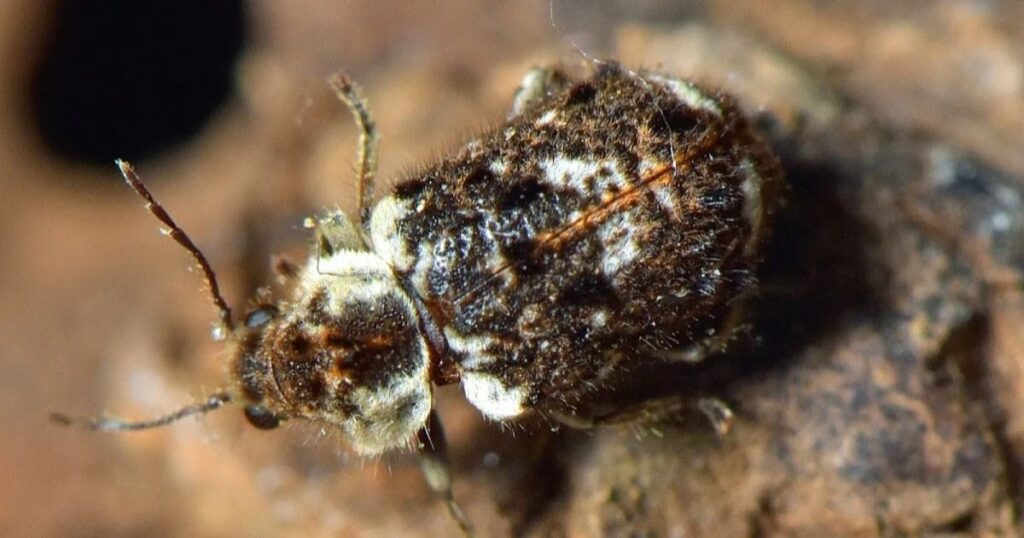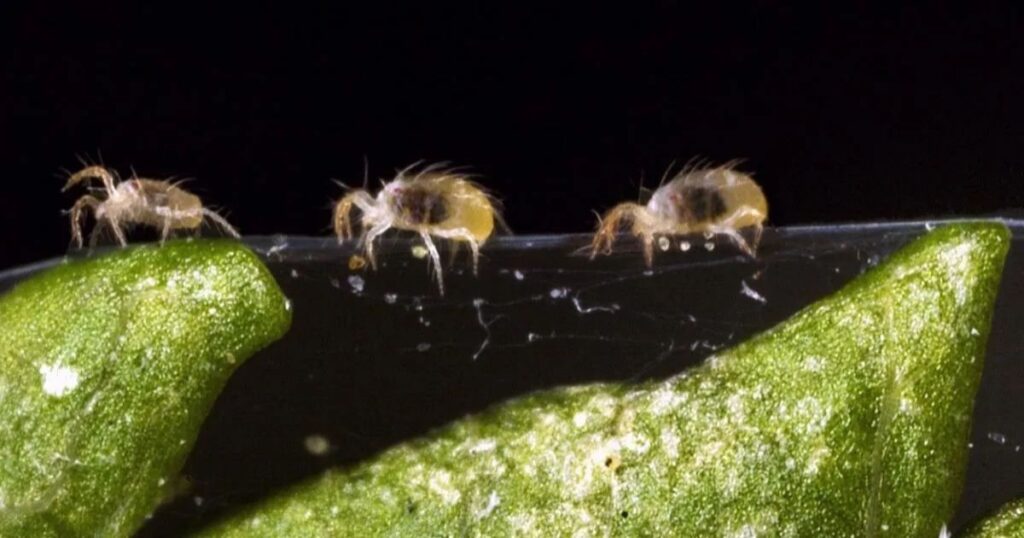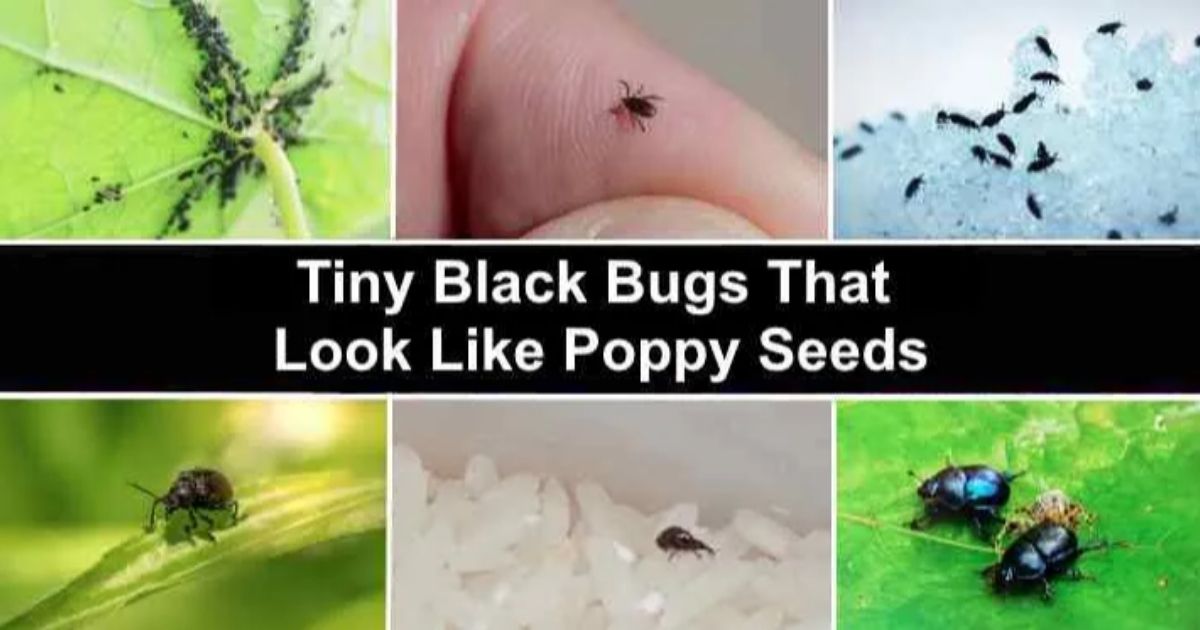Have you ever noticed strange small bugs in your home, yard, or garden that resemble tiny black seeds? These minuscule creatures, often mistaken for poppy seeds, can be a source of curiosity and concern for many homeowners. In this comprehensive guide, we’ll explore 14 different types of tiny black bugs that look like poppy seeds, their characteristics, potential dangers, and effective methods to deal with them.
Tiny Black Bugs That Look Like Poppy Seeds
When it comes to identifying small black insects in your living space or outdoor areas, it’s essential to understand the various species that might be present. These seed-sized bugs can range from harmless soil dwellers to potential pests that may cause damage to your plants or home. Let’s dive into the world of these fascinating tiny creatures and learn how to distinguish between them.
1. Moss mites
Moss mites, also known as oribatid mites, armored mites, moss beetles, or beetle mites, are among the bugs that most closely resemble poppy seeds. These tiny black bugs are typically found in outdoor environments, particularly in shaded areas of gardens and yards.
Characteristics:
- Size: 1-2mm (0.04-0.08 inches) in length
- Shape: Round
- Color: Black
- Habitat: Usually found under plant leaves, in soil, or on compost piles
Are they dangerous?
Moss mites are entirely harmless and pose no threat to humans, pets, or plants. They play a beneficial role in the ecosystem by breaking down dead organic matter and enriching the soil with nutrients.
How to deal with moss mites:
Since moss mites are beneficial to your garden, there’s no need to eliminate them. If you find them on your pet’s fur, simply remove them with a comb.
Electric Rechargeable UV Light Bug Zapper Racket
While not necessary for dealing with moss mites, this device can be useful for controlling other flying insects in your home or garden.
Upgraded 3000V Electric Bug Zapper Racket
Another option for tackling flying pests, is this powerful zapper racket can help maintain a bug-free environment.
Also read this post:disposable vape pods and setting new standards in the USA market.
Portable Three-layer Safety Bug Zapper Racket
A compact and safe option for dealing with small flying insects, this portable zapper racket is ideal for on-the-go use.
2. Black aphids

Black aphids are another type of tiny black bug that can resemble poppy seeds. These small insects are part of the larger aphid family, which includes various species in different colors.
Characteristics:
- Size: 1-2mm (0.04-0.08 inches) in length
- Color: Black
- Activity: Most active in spring and summer
- Common species: Citrus aphids and peach aphids
Are they dangerous?
While black aphids don’t pose a direct threat to humans, they can be harmful to plants. These pests feed on plant sap, causing damage to leaves and potentially spreading plant diseases.
How to get rid of black aphids:
To combat an aphid infestation, mix water and dishwashing liquid in a spray bottle and apply it to the affected plants. Repeat the treatment for several days to ensure complete eradication.
3. Fleas
Fleas are jumping parasitic insects that can infest pets and occasionally bite humans. These tiny black bugs are a common concern for pet owners and can sometimes be mistaken for poppy seeds.
Characteristics:
- Size: Up to 3mm (0.12 inches) in length
- Shape: Oval, laterally compressed
- Color: Dark brown to black
- Behavior: Known for their jumping ability
Are they dangerous?
While flea bites are usually more of a nuisance than a serious health concern, fleas can carry diseases. The oriental rat flea, for example, is known to transmit the bacterium responsible for bubonic plague.
How to get rid of fleas:
Dealing with a flea infestation requires a multi-faceted approach:
- Vacuum your home thoroughly
- Wash all bedding in hot water
- Use flea treatments on your pets
- Apply flea repellents to prevent future infestations
4. Flea beetles
Despite their name, flea beetles are not related to fleas. These small insects are plant pests that can cause significant damage to leaves and crops.
Characteristics:
- Size: 1-3mm (0.04-0.12 inches) in length
- Shape: Oval
- Color: Shiny black
- Behavior: Known for jumping when disturbed
Are they dangerous?
Flea beetles are not dangerous to humans or animals, but they can cause extensive damage to plants, especially in vegetable gardens.
How to get rid of flea beetles:
To control flea beetles, you can use commercial insecticides or create a homemade solution using soapy water mixed with olive oil. Apply this mixture to affected plants regularly.
5. Bed bugs
Bed bugs are notorious household pests that can resemble dark brown poppy seeds before feeding. After a meal, they swell up and turn a blackish-red color.
Characteristics:
- Size: 4-5mm (0.16-0.20 inches) in length
- Shape: Oval, flat (unfed) or round (fed)
- Color: Dark brown to reddish-brown
- Habitat: Hide in mattresses, furniture, and cracks during the day
Are they dangerous?
While bed bugs are not known to transmit diseases, their bites can cause itching and discomfort. Infestations can lead to psychological stress and sleep disturbances.
How to get rid of bed bugs:
Eliminating bed bugs requires a comprehensive approach:
- Use a steam cleaner on infested areas
- Wash and dry all bedding and clothing on high heat
- Use bed bug-specific insecticides
- Consider professional pest control services for severe infestations
6. Ticks
Ticks are arachnids that can resemble poppy seeds, especially when they haven’t yet fed. These parasitic creatures attach themselves to humans and animals to feed on blood.
Characteristics:
- Size: Varies by species, typically 1-3mm (0.04-0.12 inches) unfed
- Shape: Oval or round
- Color: Brown to black, may change color after feeding
- Habitat: Commonly found in wooded or grassy areas
Are they dangerous?
Ticks can be dangerous as they are known carriers of various diseases, including Lyme disease, Rocky Mountain spotted fever, and babesiosis.
How to deal with ticks:
Prevention is key when it comes to ticks:
- Use tick repellents when outdoors
- Wear long sleeves and pants in tick-prone areas
- Check yourself and your pets for ticks after outdoor activities
- If a tick is found attached, use a proper tick removal tool to safely remove it
Rechargeable Electric Cordless Indoor Bug Zapper
This device can be useful for controlling flying insects indoors, providing a chemical-free solution to bug problems.
Electric Handheld Fly Swatter Indoor Bug Zapper
A handheld option for dealing with individual flying insects, this zapper is easy to use and effective.
3000V UV Light USB Charging Indoor Bug Zapper
This powerful indoor bug zapper uses UV light to attract and eliminate flying pests, helping to maintain a bug-free environment.
7. Black carpet beetles
Black carpet beetles are small insects that can infest homes, causing damage to natural fibers and stored foods.
Characteristics:
- Size: 2-3mm (0.08-0.12 inches) in length
- Shape: Oval
- Color: Black or dark brown
- Behavior: Adults lay eggs in spring and summer
Are they dangerous?
While not directly harmful to humans, carpet beetle larvae can cause skin irritation. The main concern is the damage they can cause to fabrics, carpets, and stored foods.
How to get rid of black carpet beetles:
To eliminate carpet beetles:
- Vacuum thoroughly and frequently
- Steam clean carpets and upholstery
- Use insecticides designed for carpet beetles
- Discard infested food items
- Store susceptible items in airtight containers
8. American spider beetles

American spider beetles are unique-looking insects that resemble small spiders but are beetles.
Characteristics:
- Size: 1.5-3.5mm (0.06-0.14 inches) in length
- Shape: Round body with long legs
- Color: Reddish-brown to black
- Habitat: Often found in pantries and food storage areas
Are they dangerous?
Spider beetles are not dangerous to humans but can be a nuisance if they infest stored foods.
How to get rid of American spider beetles:
To control spider beetles:
- Locate and remove infested food sources
- Clean and vacuum storage areas thoroughly
- Use sticky traps to monitor for activity
- Apply insecticides if necessary
9. Drugstore beetles
Drugstore beetles, also known as bread beetles or biscuit beetles, are common pantry pests that can infest a wide variety of dry goods.
Characteristics:
- Size: 2-3mm (0.08-0.12 inches) in length
- Shape: Cylindrical
- Color: Light brown to reddish-brown
- Behavior: Can bore through packaging to access food
Are they dangerous?
While not harmful to humans, drugstore beetles can contaminate and damage stored foods, making them unfit for consumption.
How to get rid of drugstore beetles:
To eliminate drugstore beetles:
- Inspect and discard infested food items
- Clean pantry areas thoroughly
- Use pheromone traps to monitor for activity
- Store susceptible foods in airtight containers
- Consider using food-safe insecticides for severe infestations
10. Fungus gnats
Fungus gnats are small flying insects that resemble tiny mosquitoes and are often found around houseplants.
Characteristics:
- Size: 2-4mm (0.08-0.16 inches) in length
- Shape: Slender body with long legs
- Color: Gray to black
- Habitat: Moist soil of potted plants
Are they dangerous?
Fungus gnats are not harmful to humans but can be a nuisance. In large numbers, their larvae may damage plant roots.
How to get rid of fungus gnats:
To control fungus gnats:
- Allow the top layer of soil to dry between waterings
- Use sticky traps to catch adult gnats
- Apply a solution of water and hydrogen peroxide to the soil
- Consider using biological control methods like beneficial nematodes
11. Baby black oriental cockroaches
Baby black oriental cockroaches, also known as nymphs, can resemble tiny black seeds when newly hatched.
Characteristics:
- Size: 1-2mm (0.04-0.08 inches) when newly hatched
- Shape: Oval
- Color: Dark brown to black
- Habitat: Damp, dark areas in homes and buildings
Are they dangerous?
While not directly harmful, cockroaches can spread bacteria and trigger allergies in some people.
How to get rid of baby black oriental cockroaches:
To eliminate cockroach infestations:
- Identify and seal entry points
- Remove food and water sources
- Use cockroach baits and traps
- Apply insecticides designed for cockroaches
- Maintain cleanliness and reduce clutter
12. Black weevils
Black weevils, also known as granary weevils or pantry weevils, are small beetles that infest stored grains and dry foods.
Characteristics:
- Size: 2-3mm (0.08-0.12 inches) in length
- Shape: Oval with a distinctive snout
- Color: Dark brown to black
- Behavior: Can chew through packaging to access food
Are they dangerous?
While not harmful to humans, black weevils can contaminate and damage stored foods, making them unfit for consumption.
How to get rid of black weevils:
To control black weevils:
- Inspect and discard infested food items
- Clean storage areas thoroughly
- Freeze susceptible foods for several days before storage
- Use airtight containers for food storage
- Consider using pheromone traps or food-safe insecticides for severe infestations
Pet Collar Tick Ultrasonic Pest Control Repeller
This device can help protect pets from ticks and other parasites, providing an additional layer of defense against these tiny black bugs.
P82D Electronic Ultrasonic Pest Control Repeller
An electronic pest repeller that can help deter various insects and rodents from entering your home.
Portable USB Indoor Ultrasonic Pest Control Repeller
A compact and portable option for pest control, this device can be useful in various indoor settings.
13. Spider mites

Spider mites are tiny arachnids that can infest plants, causing damage to leaves and potentially killing the plant if left unchecked.
Characteristics:
- Size: Less than 1mm (0.04 inches) in length
- Shape: Oval
- Color: Varies by species, often reddish-brown or black
- Behavior: Spin fine webbing on plants
Are they dangerous?
Spider mites are not dangerous to humans but can cause significant damage to plants.
How to get rid of spider mites:
To control spider mites:
- Spray plants with a strong stream of water to dislodge mites
- Use insecticidal soaps or horticultural oils
- Introduce natural predators like ladybugs or predatory mites
- Maintain proper plant care to prevent future infestations
14. Poop
While not an insect itself, the droppings of certain pests can resemble tiny black seeds and may indicate an infestation.
Characteristics:
- Size: Varies depending on the pest
- Shape: Often small, round pellets
- Color: Dark brown to black
- Location: Near wooden structures (for termites) or in dark corners (for cockroaches)
Are they dangerous?
While pest droppings themselves are not typically dangerous, they can indicate the presence of harmful pests like termites or disease-carrying cockroaches.
How to deal with pest droppings:
- Identify the source of the droppings
- Clean and disinfect the area thoroughly
- Inspect for signs of pest activity
- Implement appropriate pest control measures based on the identified pest
Several possibilities
As we’ve explored in this comprehensive guide, numerous tiny black bugs can resemble poppy seeds. From harmless soil dwellers like moss mites to potentially damaging pests like black carpet beetles, each of these small insects has its unique characteristics and potential impacts on your home and garden.
When dealing with any of these tiny black bugs, it’s essential to properly identify the species before taking action. This will help you implement the most effective and appropriate control measures while avoiding unnecessary use of pesticides or other treatments.
Remember that many of these small insects play important roles in our ecosystems, and not all of them require immediate eradication. By understanding the nature of these tiny black bugs and their potential impacts, you can make informed decisions about how to manage their presence in your home and garden.
If you’re unsure about the identity of a particular bug or are dealing with a severe infestation, don’t hesitate to consult with a professional pest control expert. They can provide accurate identification and tailored solutions to address your specific pest concerns.
By staying informed and proactive, you can maintain a healthy balance in your living spaces and outdoor areas, ensuring that these tiny black bugs that look like poppy seeds don’t become a significant problem for you or your plants.
FAQs
What are the tiny bugs that look like black seeds?
The tiny bugs that look like black seeds could be several different species, including moss mites, black aphids, or flea beetles. These small insects are often found in gardens, on plants, or sometimes indoors, and their small size and dark coloration can make them resemble seeds at first glance.
What are the tiny little black bugs?
Tiny little black bugs could be a variety of insects, such as carpet beetles, fungus gnats, or spider mites. The specific identity depends on where they are found and their behavior, as each species has its unique characteristics and preferred habitats.
What bugs leave little black dots?
Bugs that leave little black dots are often flea dirt (flea feces) or cockroach droppings. These small, dark specks can be indicators of an infestation and are often found in areas where these pests are active, such as on pet bedding or in dark corners of kitchens and bathrooms.
What are the little bugs that look like chia seeds?
The little bugs that look like chia seeds could be carpet beetle larvae or drugstore beetles. These small insects are often found in homes and can infest stored foods or fabrics, with their oval shape and dark coloration resembling small seeds like chia.











